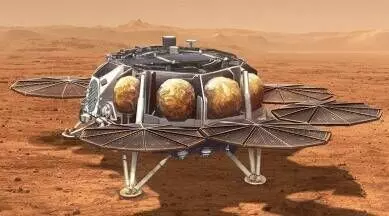
16-member Mars Sample Return Campaign Science team set up by NASA & ESA
text_fieldsNASA and the European Space Agency (ESA) have set up a new team of researchers to maximize the scientific potential of rocks and sediment samples on Mars, which will be brought back to Earth for in-depth analysis. Both agencies have partnered in the Mars Sample Return Program.
The 16-member researcher group will be known as the 'Mars Sample Return Campaign Science Group' and will serve as a scientific resource for the campaign's project teams and related Earth - based projects such as sample retrieval and curation.
The following are the members of the Mars Sample Return Campaign Science Group:
Laura Rodriguez – NASA's Jet Propulsion Laboratory, Southern California
Michael Thorpe – Johnson Space Center Engineering, Technology and Science at NASA's Johnson Space Center, Houston / Texas State University, San Marcos
Audrey Bouvier – Bayerisches Geoinstitut, Universität Bayreuth, Germany
Andy Czaja – Department of Geology, University of Cincinnati
Nicolas Dauphas – Origins Laboratory, the University of Chicago
Katherine French – Central Energy Resources Science Center, U.S. Geological Survey, Denver
Lydia Hallis – School of Geographical and Earth Sciences, University of Glasgow, UK
Rachel Harris – Department of Organismic and Evolutionary Biology, Harvard University, Boston
Ernst Hauber – Institute of Planetary Research, German Aerospace Center, Germany
Suzanne Schwenzer – School of Earth, Environment and Ecosystem Sciences, the Open University, UK
Andrew Steele – Earth and Planetary Laboratory, Carnegie Institution of Washington
Kimberly Tait – Department of Natural History, Royal Ontario Museum, Canada
Tomohiro Usui – Japan Aerospace Exploration Agency
Jessica Vanhomwegen – Laboratory for Urgent Response to Biological Threats, Institut Pasteur, France
Michael Veibel – Department of Earth and Environmental Sciences, Michigan State University
Maria-Paz Zorzano Mier – Astrobiology Center, National Institute for Aerospace Technology, Spain
Michael Meyer, the Mars Exploration Program head scientist at NASA Headquarters in Washington spoke to the press and said, "These 16 individuals will be the standard-bearers for Mars Sample Return science. They will build the roadmap by which science for this historic endeavor is accomplished – including establishing the processes for sample-related decision-making and designing the procedures that will allow the worldwide scientific community to become involved with these first samples from another world", the Indian Express reported.
The team has been selected to "revolutionise humanity's understanding of Mars by bringing scientifically selected samples to NASA's Mars Sample Return Campaign. The campaign will fulfil a solar system exploration goal, which has been of high priority since the 1970s for the space agency."
This partnership between the two agencies will be the first mission to return samples from another planet and also the first to launch from another planet's surface. Samples from an ancient lakebaed had been colleted by NASA's Perseverance Mars rover during an exploration.
The samples that have been collected are seen to be an excellent opportunity to reveal clues about the early evolution of the Red Planet, including the possibility of a past life.
This knowledge of Mars will equip us to better our understanding of other rocky planets like it, including Earth.






















